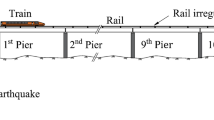Abstract
This study is intended to evaluate the influence of dynamic bridge-train interaction (BTI) on the seismic response of the Shinkansen system in Japan under moderate earthquakes. An analytical approach to simulate the seismic response of the BTI system is developed. In this approach, the behavior of the bridge structure is assumed to be within the elastic range under moderate ground motions. A bullet train car model idealized as a sprung-mass system is established. The viaduct is modeled with 3D finite elements. The BTI analysis algorithm is verified by comparing the analytical and experimental results. The seismic analysis is validated through comparison with a general program. Then, the seismic responses of the BTI system are simulated and evaluated. Some useful conclusions are drawn, indicating the importance of a proper consideration of the dynamic BTI in seismic design.
Similar content being viewed by others
References
Agabein ME (1971), “The Effect of Various Damping Assumptions on the Dynamic Response of Structure,” Bulletin of International Institute of Seismology and Earthquake Eng, 8: 217–236.
Diana G, Cheli F and Bruni S (2000), “Railway Runnability and Train-track Interaction in Long Span Cable Supported Bridges,” Advances in Structural Dynamics, 1: 43–54.
Han Y, Xia H, Guo W and Zhang N (2003), “Dynamic Analysis of Cable-stayed Bridge Subjected to Running Trains and Earthquakes,” Environmental Vibration, Beijing: China Communications Press, pp. 242–251.
He X, Kawatani M, Hayashikawa T and Matsumoto T (2009), “Seismic Response Evaluation of Shinkansen Train-bridge Interaction System Under Moderate Earthquakes,” Proc. of 4th International Symposium on Environmental Vibrations (ISEV2009), Beijing, China, pp.1276–1281.
He X, Kawatani M, Sobukawa R and Nishiyama S (2005), “Dynamic Response Analysis of Shinkansen Train-Bridge Interaction System Subjected to Seismic Load,” Proc. of 4th International Conference on Current and Future Trends in Bridge Design, Construction and Maintenance, Kuala Lumpur, Malaysia, (CD-ROM), 1–12.
Kawatani M, He X, Shiraga R, Masaki S, Nishiyama S and Yoshida K (2006), “Dynamic Response Analysis of Elevated Railway Bridges due to Shinkansen Trains,” Journal of Structural and Earthquake Engineering, JSCE, 62(3): 509–519. (in Japanese)
Kawatani M, He X, Sobukawa R and Nishiyama S (2004), “Traffic-induced Dynamic Response Analysis of High-speed Railway Bridges,” Proc. of the Third Asian-Pacific Symposium on Structural Reliability and Its Applications, Seoul, Korea, pp. 569–580.
Kim CW, Kawatani M and Kim KB (2005), “Threedimensional Dynamic Analysis for Bridge-vehicle Interaction with Roadway Roughness,” Computers and Structures, 83(19–20): 1627–1645.
Kim CW and Kawatani M (2006), “Effect of Train Dynamics on Seismic Response of Steel Monorail Bridges Under Moderate Ground Motion,” Earthquake Engineering & Structural Dynamics, 35(10): 1225–1245.
Matsumoto N, Sogabe M, Wakui H and Tanabe M (2004), “Running Safety Analysis of Vehicles on Structures Subjected to Earthquake Motion,” QR of RTRI, 45(3): 116–122.
Miura S (1996), “Deformation of Track and Safety of Train in Earthquake,” QR of RTRI, 37(3): 139–147.
Miyamoto T, Ishida H and Matsuo M (1997), “Running Safety of Railway Vehicle as Earthquake Occurs,” QR of RTRI, 38(3): 117–122.
Miyamoto T, Sogabe M, Shimomura T, Nishiyama Y, Matsumoto N and Matsuo M (2003), “Real-size Experiment and Numerical Simulation of Dynamic Behavior of Railway Vehicle against Track Vibration,” RTRI Report, 17(9): 39–44. (in Japanese)
National Research Institute for Earth Science and Disaster Prevention (NIED), Kyoshin Network (KNET), http://www.k-net.bosai.go.jp.
Newmark NM (1959), “A Method of Computation for Structural Dynamics,” Journal of the Engineering Mechanics Division, ASCE, 85(EM3): 67–94.
Railway Technical Research Institute (RTRI) (1999), Seismic Design Code for Railway Structures, Maruzen Co., Ltd.: Tokyo, Japan. (in Japanese)
Tanabe M, Wakui H and Matsumoto N (1993), “The Finite Element Analysis of Dynamic Interactions of High-speed Shinkansen, Rail, and Bridge,” ASME Computers in Engineering, G0813A: 17–22.
Xia H, De Roeck G, Zhang HR and Zhang N (2001), “Dynamic Analysis of Train-bridge System and Its Application in Steel Girder Reinforcement,” Computers and Structures, 79: 1851–1860.
Yang YB and Wu YS (2002), “Dynamic Stability of Trains Moving over Bridges Shaken by Earthquakes,” J. of Sound and Vibration, 258(1): 65–94.
Author information
Authors and Affiliations
Corresponding author
Additional information
Supported by: Japan Society of the Promotion of Science (Grant-in-Aid for Scientific Research (B) Under Project No. 17360213) and the Hyogo Science and Technology Association
Rights and permissions
About this article
Cite this article
He, X., Kawatani, M., Hayashikawa, T. et al. Numerical analysis on seismic response of Shinkansen bridge-train interaction system under moderate earthquakes. Earthq. Eng. Eng. Vib. 10, 85–97 (2011). https://doi.org/10.1007/s11803-011-0049-1
Received:
Accepted:
Published:
Issue Date:
DOI: https://doi.org/10.1007/s11803-011-0049-1




